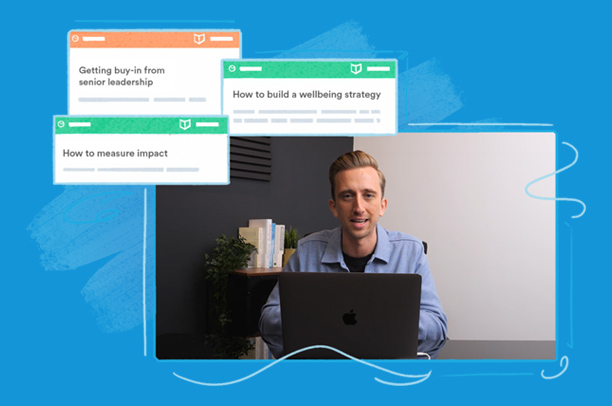Dealing with workplace anxiety can be very challenging. The harder you try to get yourself out of an anxiety loop, the deeper you find yourself in it.
Nearly 40 million adults between 18-54 worldwide have suffered from an anxiety disorder at some stage in their working life and in 2020/21 stress, depression or anxiety accounted for 50% of all work-related ill health cases. To make matters worse, a survey conducted by TalkOut presents over half of workers living with anxiety disorders have not had access to mental health support.
With the effects of the pandemic still being felt, employers have put wellbeing high on the agenda either building their first mental health strategy from scratch or revamping their existing strategy to ensure employees remain happy, healthy and productive.
In this article, we’re going to cover how you as an employer can correctly manage an employee with anxiety, ensuring that you provide the right support.
What Causes Workplace Anxiety?
Anxiety is different from workplace stress. Stress is often onset by deadlines and juggling demanding tasks at work, however, anxiety can feel like life is out of control. Anxiety in the workplace is often caused by:
- Heavy workloads
- Poor management (lack of communication, micro-managing)
- Long working hours
- Lack of autonomy
- Conflicts with colleagues
Workplace anxiety is a growing problem for many workers, in a variety of different sectors. There are steps individuals can take to support how they are feeling and reduce their feelings of anxiety, however it’s important for employers to be proactive in helping employees manage anxiety. In doing so, employees are less likely to experience work-related mental ill-health leading to a happier, more productive workforce.
If you’re looking to assess the mental health risks within your workplace including workplace anxiety and stress, we recommend using our free workplace mental health risk assessment template just here.
Under the Health and Safety at Work Act 1974, every employer has a duty to ensure that, so far as is reasonably practicable, the health, safety and welfare of employees are protected. Employers must conduct a risk assessment to identify the measures necessary to comply with the Act and other regulations.
You can also check out our recent podcast here with Debbie Bullock (UK Wellbeing Lead at Aviva) where we discuss strategies you can utilise to promote positive wellbeing and help those who may be experiencing anxiety or depression:
Create A Friendly Environment
The atmosphere in our work environment can often dictate the mood amongst employees. Toxic work environments can fast become breeding grounds for anxiety disorders or depression and can often stem from an unhealthy workplace culture. This can come from a whole variety of sources such as negative culture, poor relationships or disorganised processes to name a few.
Ultimately, an employer must recognise that employee wellbeing is impacted by everything. Businesses must start by adopting a truly supportive stance surrounding mental health and wellbeing, tackling stigma within the business and reviewing the existing culture and workplace practices that might negatively impact the working environment.
Never overlook the impact of culture (HR and People Professionals know this all too well). Employers must focus on creating a warm, friendly environment that creates a sense of belonging and understanding. Lead by being supportive and do everything you can to ensure employees don’t feel alone with their challenges, especially around mental health. One of the best ways to demonstrate this support is by having leadership share their own mental health story. When it comes from the top down, it changes everything.
Have An Open Door Policy
Many who experience anxiety at work fear talking to a manager and opening up about how they feel to then find themselves with exasperated symptoms. However, employees should feel comfortable speaking with their employer about issues they are facing at work.
Be able to speak openly about personal issues fosters a community-led workplace that will not only encourage each other, but will be better equipped for future concerns that may arise.
Adopt a Confidentiality Policy
Once an employee opens up about any concern of theirs, whether physical or mental, it is really important employers ensure any information on the matter is kept strictly confidential. Unless you believe the individual or someone is in danger.

Talking about how we feel can come with challenges for a lot of us, and trust is an important element of this. Ensure all conversations with anyone about their mental health is done in a private and comfortable space and consider the employees’ well being throughout the entire process.
Manage Expectations
When managing an employee with anxiety, it’s okay for you to make a plan outlining what you expect of them during that time. However, the goal here is to remove uncertainty or tangibles that may increase stress or anxiety, this is not about trying to pin them down or force more challenging expectations on them. This also means being thoughtful about when to approach particular topics.
For instance, if an employee has just experienced a severe episode of anxiety you should not be raising targets and KPIs with them. In that moment, they need your support and discussions that relate to performance or business needs must be raised when they’re calmer and able to discuss them appropriately. Your aim is to establish trust and create an open dialogue that keeps communication strong, helping the employee to manage their anxiety with measures that support them, whilst also supporting the business.
Promote Flexibility
Anxiousness and depression comes in waves for all of us, some days will be worse than others. With this in mind, it is really important for employers to adopt a flexible working style. An employee suffering with anxiety may require additional time for assignments or need small adjustments to be made in their workload or hours.
In order for this to be kept under control, however, is to ensure employers communicate flexibility is to be done on a limited basis. Flexibility can be managed by maintaining a good level of communication to ensure the individual is applying their best efforts to get up to speed and back to normal soon.
Under the Equality Act, it’s key that you also consider reasonable adjustments for the employee so they’re not at a disadvantage at work. Adjustments must be tailored to the individual, with anxiety in particular it depends on what is causing the anxiety. For example, if an employee is anxious about travelling in crowded transport, the employer might make their start/finish times flexible so that they can avoid rush hour. In general, reasonable adjustments target the workplace, equipment or how/when/where tasks and responsibilities are carried out. This guidance published by the NHS may also help with approaching reasonable adjustments.
Provide Constructive Feedback
Feedback is really important in the workplace, however, criticism is not. Providing additional constructive feedback to an employee suffering with anxiety helps them to better manage their goals and expectations.
In some cases, regular reviews can also lead to increased anxiety. Therefore, it is especially important as an employer you focus on what the individual is doing well in, and provide support in areas of improvement.
Offer Support
Support is your biggest ally in ensuring employees are happy and comfortable at work. Showing concern and approaching situations with caution and understanding creates a safe environment. Supporting an employee with anxiety has a significant impact on their attitude towards work and how they perform.
Whilst the conversation around mental health is gradually becoming de-stigmatised, words without action are irrelevant. This advice can help employers and businesses demonstrate the care and attention they give to the well being of their employees. By taking better care of our mental health we’re able to perform better in work and see an increase in overall job satisfaction.
Finally, if you’d like to conduct an audit of your workplace, you can download our free Workplace Mental Health & Wellbeing Risk Assessment just here. Please note that this mental wellbeing risk assessment is designed to complement (not replace) your existing generic H&S risk assessments and is specifically related to mental wellbeing.








